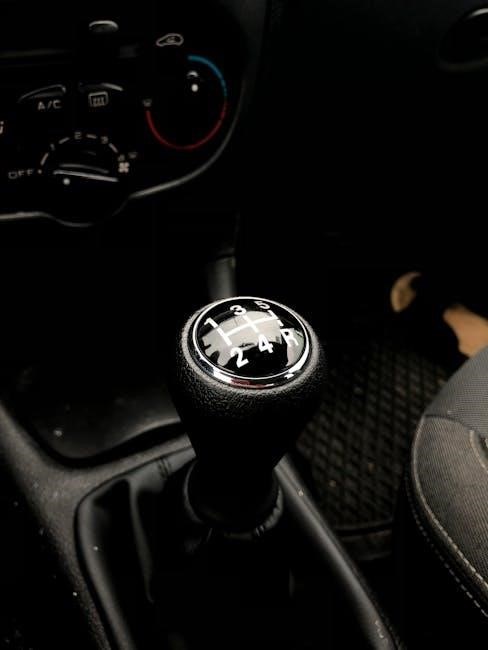mn driver’s manual pdf
The Minnesota Driver’s Manual is a comprehensive guide for all drivers, covering traffic laws, road signs, safe practices, and interactions with law enforcement. Available as a free PDF, it ensures motorists are well-prepared to operate vehicles safely and responsibly.
Overview of the Manual
The Minnesota Driver’s Manual is a detailed guide designed to help drivers understand traffic laws, road signs, and safe driving practices. It covers essential topics such as general traffic laws, right-of-way rules, and speed limits. The manual also includes sections on road signs, traffic signals, and interactions with law enforcement. Regularly updated, it reflects current regulations and provides clear guidance for all drivers, from first-time applicants to experienced motorists. Available in PDF format, it offers a convenient way to study and prepare for driving exams or refresh knowledge of state-specific rules.
Importance of the Manual for Drivers
The Minnesota Driver’s Manual is essential for all motorists, providing critical information on traffic laws, road safety, and driver responsibilities. It serves as a primary resource for learning safe driving practices, understanding road signs, and preparing for licensing exams. The manual ensures compliance with state-specific regulations, helping drivers avoid violations and stay informed about updates, such as guidance for legally carrying firearms during traffic stops. It is a vital tool for both new and experienced drivers, promoting confidence and legal adherence on Minnesota roads.
Availability of the Manual in PDF Format
The Minnesota Driver’s Manual is readily available for download as a free PDF from the Minnesota Department of Public Safety’s website. This convenient format allows drivers to access essential information on traffic laws, road signs, and safe driving practices anytime, anywhere. The manual is regularly updated to reflect current regulations, ensuring motorists have the most accurate guidance. While physical copies are no longer provided at no cost, the PDF version remains a reliable and accessible resource for all drivers in Minnesota.

Rules of the Road
The Minnesota Driver’s Manual outlines essential traffic laws, including right-of-way rules, speed limits, and safe driving practices to ensure road safety for all motorists.
General Traffic Laws in Minnesota
The Minnesota Driver’s Manual details fundamental traffic laws to ensure safety and order on the roads. These laws cover vehicle registration, insurance requirements, and prohibited practices such as reckless driving. They also emphasize the importance of following traffic signals and signs to maintain a safe environment for all road users.
Adhering to these laws is crucial for drivers to avoid penalties and contribute to responsible driving practices statewide. The manual serves as a primary resource for understanding and complying with Minnesota’s traffic regulations effectively.
Right-of-Way Rules
The Minnesota Driver’s Manual outlines clear right-of-way rules to reduce conflicts and enhance safety. At intersections, drivers must yield to vehicles on their right if arriving at the same time. Pedestrians always have priority in crosswalks. Emergency vehicles, such as ambulances or fire trucks, must be given the right of way immediately. Additionally, drivers turning left must yield to oncoming traffic unless a green arrow signal is present. Understanding and adhering to these rules is essential for smooth and accident-free traffic flow.
Speed Limits and Safe Driving Practices
Adhering to speed limits is crucial for road safety in Minnesota. The manual emphasizes adjusting speed according to road conditions, such as rain, snow, or heavy traffic. Drivers should maintain a safe distance from other vehicles to allow time to react. Safe practices include using turn signals consistently, avoiding distractions like texting, and being aware of surroundings. Always wear a seatbelt, as it significantly reduces the risk of injury or fatality in collisions. By following these guidelines, drivers can contribute to a safer and more orderly traffic environment.

Road Signs and Signals
Road signs and signals guide drivers safely through Minnesota’s roads. Recognizing and obeying them is essential for adhering to traffic laws and ensuring safe navigation.
Types of Traffic Signs
The Minnesota Driver’s Manual categorizes traffic signs into regulatory, warning, guide, construction, and emergency types. Regulatory signs, such as speed limits and stop signs, enforce traffic laws. Warning signs, like curve ahead or pedestrian crossings, alert drivers to potential hazards. Guide signs provide directional information for highways, exits, and services. Construction and emergency signs indicate temporary conditions or emergencies. Understanding these categories helps drivers navigate safely and adhere to traffic regulations. Each sign’s shape, color, and symbols are designed for quick recognition and clear communication.
Understanding Traffic Signals and Markings
Traffic signals and pavement markings are crucial for maintaining order on Minnesota roads. Signals include standard three-color traffic lights, pedestrian signals, and directional arrows. Each color—red, yellow, and green—indicates when to stop, prepare to stop, or proceed. Pavement markings, such as dashed or solid lines, guide lane usage, merging, and turning. Understanding these signals and markings ensures compliance with traffic laws and enhances safety. The manual emphasizes recognizing and obeying these visual cues to avoid accidents and facilitate smooth traffic flow.
Commonly Confused Road Signs
The Minnesota Driver’s Manual addresses frequently misunderstood road signs to ensure clarity for drivers. Common confusions include distinguishing between yield signs and stop signs, as well as interpreting merging lane signs. The manual explains that yield signs require drivers to slow down and be ready to stop if necessary, while stop signs mandate a complete halt. Merging signs indicate where traffic lanes combine, and drivers must adjust speeds to blend safely. Understanding these differences is crucial for preventing errors and enhancing road safety.

Traffic Stops and Interactions with Law Enforcement
The Minnesota Driver’s Manual provides clear guidance on proper etiquette during traffic stops, emphasizing respect and cooperation with law enforcement to ensure safety for all parties involved.
Proper Etiquette During a Traffic Stop
The Minnesota Driver’s Manual outlines proper etiquette during a traffic stop, advising drivers to remain calm, give full attention to the officer, and avoid sudden movements. Motorists should keep their hands visible, refrain from searching for documents until instructed, and follow all officer commands. These guidelines aim to ensure a safe and respectful interaction for both drivers and law enforcement, reducing misunderstandings and potential conflicts during the stop.
Guidelines for Drivers Carrying Firearms
The Minnesota Driver’s Manual provides specific guidance for drivers carrying firearms during traffic stops. Motorists are advised to notify the officer immediately if they are carrying a firearm and follow instructions carefully. The manual emphasizes keeping hands visible, avoiding sudden movements, and not reaching for the firearm unless directed. These guidelines aim to ensure safety and clarity during interactions, helping to prevent misunderstandings between drivers and law enforcement. The updated manual reflects efforts to address legal carrying and promote respectful communication.
What to Expect During a Traffic Stop
The Minnesota Driver’s Manual outlines clear expectations for drivers during traffic stops. Motorists should remain calm, keep their hands visible, and avoid sudden movements. Drivers are advised to give their full attention to the officer and wait for instructions before searching for documents. The manual emphasizes the importance of following officer directives promptly and respectfully. These guidelines help ensure safety and clarity during interactions, reducing potential misunderstandings. The manual also covers proper communication and procedures to follow, ensuring a smooth and safe experience for both drivers and law enforcement.

Driver’s License Requirements
To obtain a Minnesota driver’s license, applicants must meet eligibility criteria, present valid identification, and pass required tests. Proper documentation is essential for a successful application.
Eligibility Criteria for a Minnesota Driver’s License
To qualify for a Minnesota driver’s license, applicants must meet specific eligibility criteria. These include being at least 16 years old for a provisional license, passing a vision test, and providing proof of identity, residency, and legal status. Minors under 18 must complete a driver’s education course and hold an instruction permit for at least six months. Applicants must also pass a written knowledge test and a vision exam. Additional documentation, such as a Social Security number and proof of insurance, may be required. Visit the DVS website for detailed requirements.
Documents Required for Application
Applicants for a Minnesota driver’s license must provide specific documents to verify identity, residency, and legal status. These include a valid Social Security card, proof of identity (e.g., birth certificate or passport), and two documents proving Minnesota residency (e.g., utility bills or lease agreements). Additional documentation may be required for non-citizens or minors. Minors under 18 must also submit parental consent. The Minnesota DVS website provides a detailed list of acceptable documents to ensure a smooth application process.
Fee Structure for Licenses and Permits
The Minnesota Driver’s Manual outlines the current fees for licenses and permits. A standard Class D driver’s license costs $25 for a 4-year renewal, while an instruction permit is $10. Commercial driver’s licenses (CDLs) have higher fees, ranging from $44 to $64, depending on the endorsement. Additional fees apply for renewals, duplicates, or upgrades. Payments can be made via cash, check, or credit card at license centers. For the most accurate pricing, visit the Minnesota DVS website or refer to the official manual.

Obtaining a Driver’s License
Obtaining a Minnesota driver’s license involves completing an application, passing vision, knowledge, and road tests, and providing required documentation. The manual guides applicants through this process.
Step-by-Step Process for First-Time Drivers
First-time drivers must obtain an instruction permit by completing an application, passing a vision test, and a knowledge exam. They then practice driving under supervision for at least 50 hours, including nighttime driving. Once ready, they schedule a road test to demonstrate safe driving skills. Upon passing, they receive a provisional license, which becomes a full license after meeting all requirements, such as completing behind-the-wheel training and maintaining a clean record.
Instruction Permits and Provisional Licenses
An instruction permit allows new drivers to practice under the supervision of a licensed adult. It is valid for two years and requires completion of 50 hours of supervised driving, including nighttime hours. After holding the permit, drivers can apply for a provisional license, which restricts passenger limits and driving hours. The provisional phase lasts until the driver turns 18 or completes the requirements successfully. This step-by-step process ensures young drivers gain experience and demonstrate readiness for full licensing.
Special Considerations for Minors
Minors under 18 must meet specific requirements to obtain a driver’s license in Minnesota. They must first hold an instruction permit for at least six months. During this period, they need to complete 50 hours of supervised driving, including 15 hours at night. Additionally, drivers under 18 are restricted from carrying more than one passenger under age 20 during the first six months of provisional licensing. These rules aim to ensure young drivers gain sufficient experience and reduce risks associated with inexperienced driving.

Safe Driving Practices
Defensive driving techniques emphasize anticipating others’ actions, maintaining safe distances, and staying alert. Sharing the road with pedestrians, cyclists, and trucks requires patience and awareness to ensure safety.
Defensive Driving Techniques
Defensive driving involves staying alert, anticipating others’ actions, and maintaining safe distances. It requires being prepared for emergencies and minimizing distractions. Drivers should avoid sudden movements, especially during traffic stops, where following officer instructions is crucial. The manual emphasizes giving full attention to officers, avoiding unnecessary actions, and waiting for guidance before retrieving documents. These practices help ensure safety on the road and during interactions with law enforcement, fostering a culture of cautious and respectful driving.
Sharing the Road with Pedestrians, Cyclists, and Trucks
Drivers must remain vigilant when sharing the road with pedestrians, cyclists, and large vehicles. Always yield to pedestrians and cyclists, giving them ample space. When interacting with trucks, maintain a safe following distance and avoid sudden lane changes. Be cautious when passing cyclists, ensuring at least three feet of clearance. Use turn signals to communicate intentions clearly. The manual emphasizes mutual respect and awareness to ensure safety for all road users, fostering a harmonious and collision-free environment.
Handling Emergency Situations
In case of an emergency, drivers should remain calm and take immediate action to ensure safety. Safely move to the side of the road and turn on hazard lights to alert others. If injured, call 911 immediately and stay in the vehicle if it’s unsafe to exit. Keep an emergency kit in the car with essentials like a flashlight, first aid supplies, and a phone charger. The manual emphasizes preparedness and quick decision-making to manage emergencies effectively and minimize risks on the road.

Updates to the Minnesota Driver’s Manual
The manual now includes updated sections on traffic stops and firearms procedures, ensuring drivers are informed about proper etiquette and safety measures during interactions with law enforcement.
Recent Changes to the Manual
The Minnesota Driver’s Manual has been updated to include new guidelines for traffic stops, particularly for drivers carrying firearms. These changes provide clear instructions on proper etiquette during interactions with law enforcement, emphasizing safety and transparency. Additionally, the manual now offers enhanced sections on defensive driving techniques and emergency situation handling, ensuring drivers are better prepared for various road scenarios. The updated PDF version is readily available online, reflecting these latest revisions to keep motorists informed and compliant with current regulations.
Firearms Guidance for Licensed Carriers
The updated Minnesota Driver’s Manual now includes specific guidance for licensed firearm carriers. It outlines proper protocols during traffic stops, such as informing officers about carried firearms and following their instructions carefully. The manual emphasizes the importance of avoiding sudden movements and waiting for the officer’s direction before accessing any documents or weapons. These guidelines aim to ensure safety and clarity for both drivers and law enforcement during interactions, promoting a calm and cooperative environment. This section is crucial for firearm carriers to understand their responsibilities and legal obligations while driving in Minnesota.
Accessing the Updated PDF Version
The updated Minnesota Driver’s Manual is readily available for free download as a PDF from the official Minnesota Department of Public Safety website. This convenient format allows drivers to access essential information anytime, anywhere. The PDF version includes all recent updates, ensuring motorists stay informed about traffic laws, road signs, and safe driving practices. Additionally, hard copies can be purchased at local License Centers for those who prefer a physical manual. This accessibility ensures all drivers can stay compliant and well-prepared for the road.

Commercial Driver’s License (CDL)
The Minnesota Driver’s Manual includes a detailed section on Commercial Driver’s Licenses, outlining specific requirements, rules, and regulations for operating commercial vehicles. This guide is essential for CDL applicants.
CDL Requirements and Restrictions
Obtaining a Commercial Driver’s License (CDL) in Minnesota requires meeting specific eligibility criteria, including age restrictions, medical certification, and passing rigorous tests. The manual outlines these requirements, ensuring drivers understand the necessary steps to qualify for a CDL. Additionally, it highlights restrictions, such as prohibitions on operating under the influence of alcohol or drugs, and the importance of maintaining a clean driving record. The guide also covers endorsements and special certifications needed for certain types of commercial vehicles, providing a clear roadmap for aspiring CDL holders.
Additional Rules for Commercial Drivers
The Minnesota Driver’s Manual outlines essential information for commercial drivers, including specific rules beyond basic requirements. It covers hours of service, cargo securement, and special regulations for oversized loads. Updated guidelines address interactions during traffic stops, particularly for drivers carrying firearms. These rules ensure compliance with federal and state laws, promoting road safety and professional conduct. Adhering to these guidelines is crucial for maintaining a valid CDL and contributing to a safer driving environment.
Manual Specifics for Commercial Vehicles
The Minnesota Driver’s Manual provides detailed guidelines for commercial vehicles, emphasizing safety and regulatory compliance. It covers pre-trip inspections, cargo securement, and weight restrictions. Commercial drivers must adhere to federal and state laws, including hours of service and vehicle maintenance standards. The manual also addresses unique challenges like hazardous material transport and oversized load requirements. These specifics ensure commercial drivers operate safely and professionally, meeting all legal obligations. The PDF version is accessible for easy reference.

Test Preparation
Study the MN Drivers Manual PDF for essential rules and signs. Utilize practice tests and interactive tools to enhance learning. Focus on defensive driving techniques and traffic laws.
Study Tips for the Written Exam
Mastering the MN Drivers Manual PDF is key to acing the written exam; Focus on understanding traffic laws, road signs, and defensive driving techniques. Highlight and review complex sections. Use interactive tools and practice tests to gauge readiness. Pay attention to commonly confused signs and safe driving practices. Simulate exam conditions to build confidence. Utilize the manual’s detailed explanations to clarify doubts. Regular practice ensures familiarity with Minnesota-specific rules and regulations, boosting your chances of success.
Practice Tests and Interactive Tools
Practice tests and interactive tools are invaluable for mastering the MN Drivers Manual PDF. These resources simulate real exam conditions, helping you identify weak areas; Utilize online platforms offering interactive quizzes and AI-driven study aids for personalized learning. Many tools provide instant feedback, clarifying correct and incorrect answers. Regularly taking practice tests improves retention of traffic laws, road signs, and safe driving practices. These tools complement the manual, ensuring a well-rounded preparation for the written exam and beyond. They make studying engaging and effective, boosting confidence for test day.
Using the Manual for Effective Learning
The MN Drivers Manual PDF is a key resource for mastering Minnesota’s driving rules and regulations. To use it effectively, start by reading thoroughly and highlighting important sections. Take notes on complex topics like road signs or traffic laws. Engage with practice tests and interactive tools to reinforce learning. Regular review helps retain information long-term. Focus on understanding concepts rather than memorizing. Use the manual in conjunction with online resources for a well-rounded study approach. This ensures confidence and readiness for the driver’s exam and safe driving practices.

